Fault-Tolerant Control for Quadrotor Based on Fixed-Time ESO
Abstract
:1. Introduction
- A fixed-time ESO is proposed to estimate and compensate the internal uncertainty, external disturbance and actuator fault of QUAV in fixed time. In contrast with other finite-time convergence ESO, the convergence time of fixed-time ESO has an upper bound and it is not influenced by the initial estimation error. The observation and disturbance rejection capability are greatly improved.
- A fixed-time continuous output feedback controller is proposed to keep the system stable quickly in fixed time and the convergence time is independent of initial conditions. Different from other multi-variable decoupling control methods, the controllers are devised independently in each channel and the strong couplings among different channels are basically eliminated. With the well previously designed fixed-time ESO, the actuator fault, external disturbance, internal uncertainty and the unmodeled dynamics are extended into a new state, which is considered as the overall disturbance and can be estimated and compensates in fixed time.
- Multiple actuator partial loss-of-effectiveness faults and external disturbance are both considered in the model of QUAV. Besides, based on fixed-time ESO, the initial system dynamic can be simplified to an integrator system.
2. System Dynamics Model
2.1. Fault-Free Model
2.2. Fault Model
3. Control Scheme
3.1. Position Control by Composite Controller
3.1.1. Controller Design for Yaw Angle Channel
3.1.2. Controller Design for Cascade Channel
3.1.3. Controller Design for Cascade Channel
3.1.4. Controller Design for Altitude Z Channel
3.2. Stability Analysis
4. Simulation Results
4.1. Constant Fault Condition
4.2. Time-Varying Fault Condition
5. Conclusions and Future Works
Author Contributions
Funding
Institutional Review Board Statement
Informed Consent Statement
Data Availability Statement
Acknowledgments
Conflicts of Interest
References
- Tian, B.; Liu, L.; Lu, H.; Zuo, Z.; Zong, Q.; Zhang, Y. Multivariable Finite Time Attitude Control for Quadrotor UAV: Theory and Experimentation. IEEE Trans. Ind. Electron. 2018, 65, 2567–2577. [Google Scholar] [CrossRef]
- Ortiz-Torres, G.; Castillo, P.; Sorcia-Vazquez, F.D.J.; Rumbo-Morales, J.Y.; Brizuela-Mendoza, J.A.; De La Cruz-Soto, J.; Martinez-Garcia, M. Fault Estimation and Fault Tolerant Control Strategies Applied to VTOL Aerial Vehicles with Soft and Aggressive Actuator Faults. IEEE Access 2020, 8, 10649–10661. [Google Scholar] [CrossRef]
- Tian, B.; Cui, J.; Lu, H.; Zuo, Z.; Zong, Q. Adaptive Finite-Time Attitude Tracking of Quadrotors with Experiments and Comparisons. IEEE Trans. Ind. Electron. 2019, 66, 9428–9438. [Google Scholar] [CrossRef]
- Hemingway, B.L.; Frazier, A.E.; Elbing, B.R.; Jacob, J.D. Vertical Sampling Scales for Atmospheric Boundary Layer Measurements from Small Unmanned Aircraft Systems (sUAS). Atmosphere 2017, 8, 176. [Google Scholar] [CrossRef] [Green Version]
- Tian, B.; Cui, J.; Lu, H.; Liu, L.; Zong, Q. Attitude Control of UAVs Based on Event-Triggered Supertwisting Algorithm. IEEE Trans. Ind. Inform. 2021, 17, 1029–1038. [Google Scholar] [CrossRef]
- Foudeh, H.A.; Luk, P.C.-K.; Whidborne, J.F. An Advanced Unmanned Aerial Vehicle (UAV) Approach via Learning-Based Control for Overhead Power Line Monitoring: A Comprehensive Review. IEEE Access 2021, 9, 130410–130433. [Google Scholar] [CrossRef]
- Shi, X.; Cheng, Y.; Yin, C.; Zhong, S.; Huang, X.; Chen, K.; Qiu, G. Adaptive Fractional-Order SMC Controller Design for Unmanned Quadrotor Helicopter under Actuator Fault and Disturbances. IEEE Access 2020, 8, 103792–103802. [Google Scholar] [CrossRef]
- Tian, B.; Fan, W.; Su, R.; Zong, Q. Real-Time Trajectory and Attitude Coordination Control for Reusable Launch Vehicle in Reentry Phase. IEEE Trans. Ind. Electron. 2015, 62, 1639–1650. [Google Scholar] [CrossRef]
- Tian, B.; Yin, L.; Wang, H. Finite-Time Reentry Attitude Control Based on Adaptive Multivariable Disturbance Compensation. IEEE Trans. Ind. Electron. 2015, 62, 5889–5898. [Google Scholar] [CrossRef]
- Wang, Z.; Yu, J.; Lin, S.; Dong, J.; Yu, Z. Distributed Robust Adaptive Fault-Tolerant Mechanism for Quadrotor UAV Real-Time Wireless Network Systems with Random Delay and Packet Loss. IEEE Access 2019, 7, 134055–134062. [Google Scholar] [CrossRef]
- Robertson, B.; Stoneking, E. Satellite GN & C anomaly trends, Guidance and Control 2003. In Proceedings of the Advances in the Astronautical Sciences, Breckenridge, CO, USA, 5–9 February 2003; Univelt Inc.: Breckenridge, CO, USA, 2003; pp. 531–542. [Google Scholar]
- Niederlinski, A. Heuristic approach to the design of linear multivariable interacting control systems. Automatica 1971, 7, 691–701. [Google Scholar] [CrossRef]
- Yin, S.; Xiao, B.; Ding, S.X.; Zhou, D. A Review on Recent Development of Spacecraft Attitude Fault Tolerant Control System. IEEE Trans. Ind. Electron. 2016, 63, 3311–3320. [Google Scholar] [CrossRef]
- Leach, R.D. Spacecraft system failures and anomalies attributed to the natural space environment. In Proceedings of the Space Programs and Technologies Conference, Reston, VA, USA, 26–28 September 1995; American Institute of Aeronautics and Astronautics Inc, AIAA: Reston, VA, USA, 1995; pp. 1–17. [Google Scholar]
- Liu, S.; Lyu, P.; Lai, J.; Yuan, C.; Wang, B. A fault-tolerant attitude estimation method for quadrotors based on analytical redundancy. Aerosp. Sci. Technol. 2019, 93, 105290. [Google Scholar] [CrossRef]
- Nian, X.; Chen, W.; Chu, X.; Xu, Z. Robust adaptive fault estimation and fault tolerant control for quadrotor attitude systems. Int. J. Control 2018, 93, 725–737. [Google Scholar] [CrossRef]
- Jeyasenthil, R.; Lee, Y.-S.; Choi, S.-B. A New Scheduling Quantitative Feedback Theory-Based Controller Integrated with Fault Detection for Effective Vibration Control. Shock Vib. 2019, 2019, 3818539. [Google Scholar] [CrossRef]
- Li, J.-N.; Ren, W. Finite-Horizon HFault-Tolerant Constrained Consensus for Multiagent Systems with Communication Delays. IEEE Trans. Cybernet. 2021, 51, 416–426. [Google Scholar] [CrossRef]
- Wang, R.; Jing, H.; Karimi, H.R.; Chen, N. Robust fault-tolerant H control of active suspension systems with finite-frequency constraint. Mech. Syst. Signal Process. 2015, 62, 341–355. [Google Scholar] [CrossRef]
- Jiang, Y.; Hu, Q.; Ma, G. Adaptive backstepping fault-tolerant control for flexible spacecraft with unknown bounded disturbances and actuator failures. ISA Trans. 2010, 49, 57–69. [Google Scholar] [CrossRef]
- Allahverdy, D.; Fakharian, A. Active fault-tolerant control system for a swash mass helicopter using back-stepping approach. Proc. Inst. Mech. Eng. Part I J. Syst. Control Eng. 2021, 236, 39–53. [Google Scholar] [CrossRef]
- Zeghlache, S.; Djerioui, A.; Benyettou, L.; Benslimane, T.; Mekki, H.; Bouguerra, A. Fault tolerant control for modified quadrotor via adaptive type-2 fuzzy backstepping subject to actuator faults. ISA Trans. 2019, 95, 330–345. [Google Scholar] [CrossRef]
- Ermeydan, A.; Kiyak, E. Fault tolerant control against actuator faults based on enhanced PID controller for a quadrotor. Aircr. Eng. Aerosp. Technol. 2017, 89, 468–476. [Google Scholar] [CrossRef]
- Hao, W.; Xian, B. Nonlinear adaptive fault-tolerant control for a quadrotor UAV based on immersion and invariance methodology. Nonlinear Dyn. 2017, 90, 2813–2826. [Google Scholar] [CrossRef]
- Guo, J.J.; Qi, J.T.; Wu, C. Robust fault diagnosis and fault-tolerant control for nonlinear quadrotor unmanned aerial vehicle system with unknown actuator faults. Int. J. Adv. Robot. Syst. 2021, 18, 17298814211002734. [Google Scholar] [CrossRef]
- Emami, S.A.; Banazadeh, A. Fault-tolerant predictive trajectory tracking of an air vehicle based on acceleration control. IET Control Theory Appl. 2020, 14, 750–762. [Google Scholar] [CrossRef]
- Xiao, B.; Hu, Q.; Wang, D. Spacecraft attitude fault tolerant control with terminal sliding-mode observer. J. Aerosp. Eng. 2015, 28, 04014055. [Google Scholar] [CrossRef]
- Zhang, A.; Hu, Q.; Zhang, Y. Observer-based attitude control for satellite under actuator fault. J. Guid. Control Dyn. 2015, 38, 806–811. [Google Scholar] [CrossRef]
- Zhao, D.; Yang, H.; Jiang, B.; Wen, L. Attitude stabilization of a flexible spacecraft under actuator complete failure. Acta Astronaut. 2016, 123, 129–136. [Google Scholar] [CrossRef]
- Li, T.; Zhang, Y.; Gordon, B.W. Nonlinear fault-tolerant control of a quadrotor UAV based on sliding mode control technique. In Proceedings of the 8th IFAC Symposium on Fault Detection, Supervision and Safety of Technical Processes, SAFEPROCESS 2012, Mexico City, Mexico, 29–31 August 2012; IFAC Secretariat: Mexico City, Mexico, 2012; pp. 1317–1322. [Google Scholar]
- Wang, B.; Zhang, Y. An Adaptive Fault-Tolerant Sliding Mode Control Allocation Scheme for Multirotor Helicopter Subject to Simultaneous Actuator Faults. IEEE Trans. Ind. Electron. 2018, 65, 4227–4236. [Google Scholar] [CrossRef] [Green Version]
- Razmi, H.; Afshinfar, S. Neural network-based adaptive sliding mode control design for position and attitude control of a quadrotor UAV. Aerosp. Sci. Technol. 2019, 91, 12–27. [Google Scholar] [CrossRef]
- Zeghlache, S.; Saigaa, D.; Kara, K.; Harrag, A.; Bouguerra, A. Backstepping sliding mode controller improved with fuzzy logic: Application to the quadrotor helicopter. Arch. Control Sci. 2012, 22, 315–342. [Google Scholar] [CrossRef]
- Gong, W.; Li, B.; Yang, Y.; Ban, H.; Xiao, B. Fixed-time integral-type sliding mode control for the quadrotor UAV attitude stabilization under actuator failures. Aerosp. Sci. Technol. 2019, 95, 105444. [Google Scholar] [CrossRef]
- Nekoukar, V.; Mahdian Dehkordi, N. Robust path tracking of a quadrotor using adaptive fuzzy terminal sliding mode control. Control Eng. Pract. 2021, 110, 104763. [Google Scholar] [CrossRef]
- Qiwei, Y.; Rui, Y. Nonsingular Terminal Sliding Mode Based Passive Fault-Tolerant Control of a 3-DOF Helicopter System. In Proceedings of the 10th IFAC Symposium on Fault Detection, Supervision and Safety for Technical Processes SAFEPROCESS 2018, Warsaw, Poland, 29–31 August 2018; Elsevier B.V.: Amsterdam, The Netherlands, 2018; pp. 1368–1372. [Google Scholar]
- Meskin, N.; Khorasani, K.; Rabbath, C.A. A Hybrid Fault Detection and Isolation Strategy for a Network of Unmanned Vehicles in Presence of Large Environmental Disturbances. IEEE Trans. Control Syst. Technol. 2010, 18, 1422–1429. [Google Scholar] [CrossRef]
- Bernard, P.; Andrieu, V.; Astolfi, D. Observer design for continuous-time dynamical systems. Annu. Rev. Control 2022, 53, 224–248. [Google Scholar] [CrossRef]
- Miladi, N.; Dimassi, H.; Said, S.H.; M’Sahli, F. Explicit nonlinear model predictive control tracking control based on a sliding mode observer for a quadrotor subject to disturbances. Trans. Inst. Meas. Control 2020, 42, 214–227. [Google Scholar] [CrossRef]
- Zhang, Y.; Chen, Z.; Zhang, X.; Sun, Q.; Sun, M. A novel control scheme for quadrotor UAV based upon active disturbance rejection control. Aerosp. Sci. Technol. 2018, 79, 601–609. [Google Scholar] [CrossRef]
- Li, J.; Liu, L.; Liu, J. Fixed-time Attitude Feedback Control for Quadrotor UAV based on Fixed-time Extended State Observer. In Proceedings of the 2021 IEEE International Conference on Mechatronics and Automation (ICMA), Takamatsu, Japan, 8–11 August 2021; pp. 176–181. [Google Scholar]
- Liu, J.; Sun, M.; Chen, Z.; Sun, Q. Output feedback control for aircraft at high angle of attack based upon fixed-time extended state observer. Aerosp. Sci. Technol. 2019, 95, 105468. [Google Scholar] [CrossRef]
- Han, J.Q. From PID to Active Disturbance Rejection Control. IEEE Trans. Ind. Electron. 2009, 56, 900–906. [Google Scholar] [CrossRef]

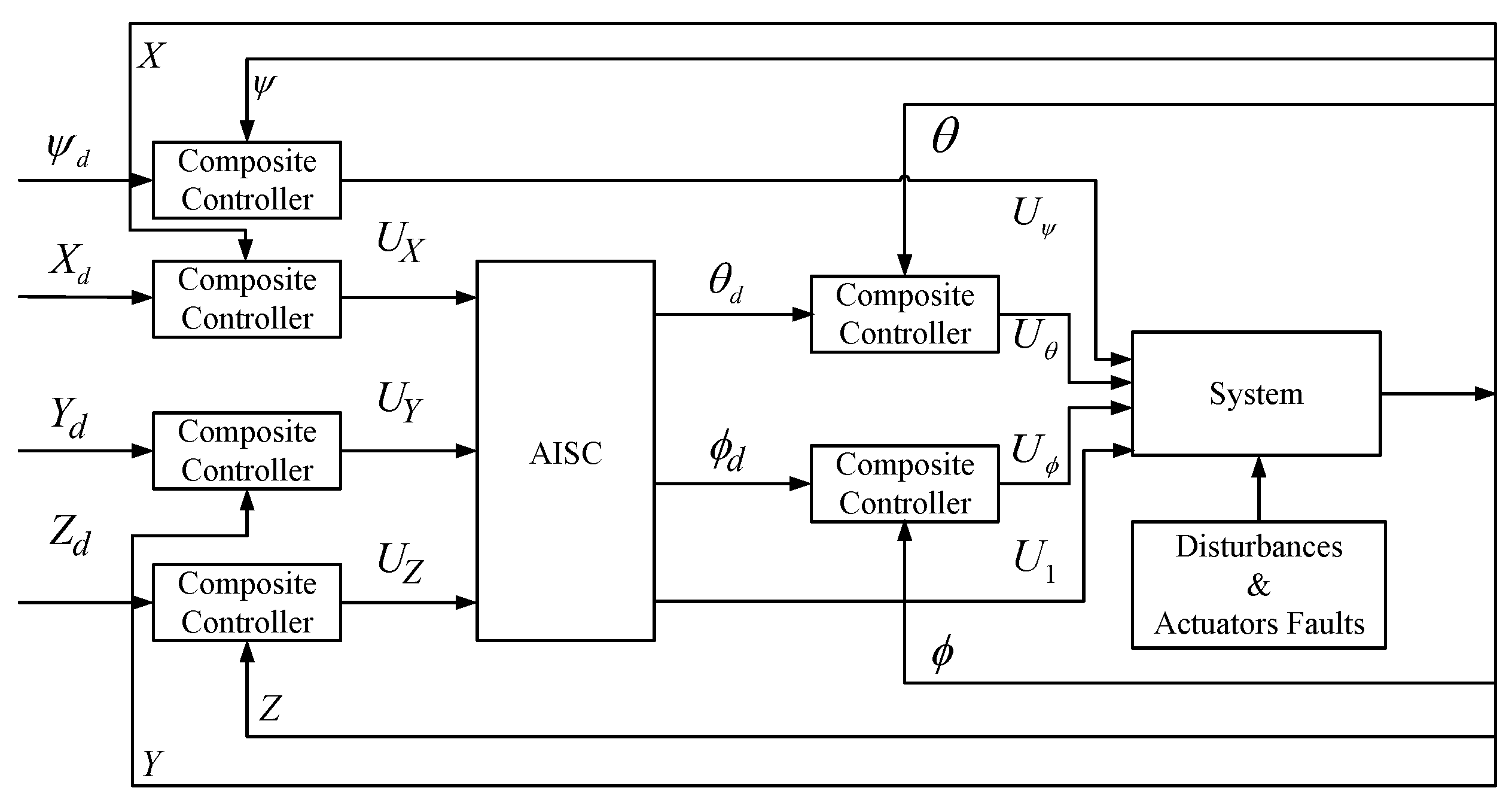

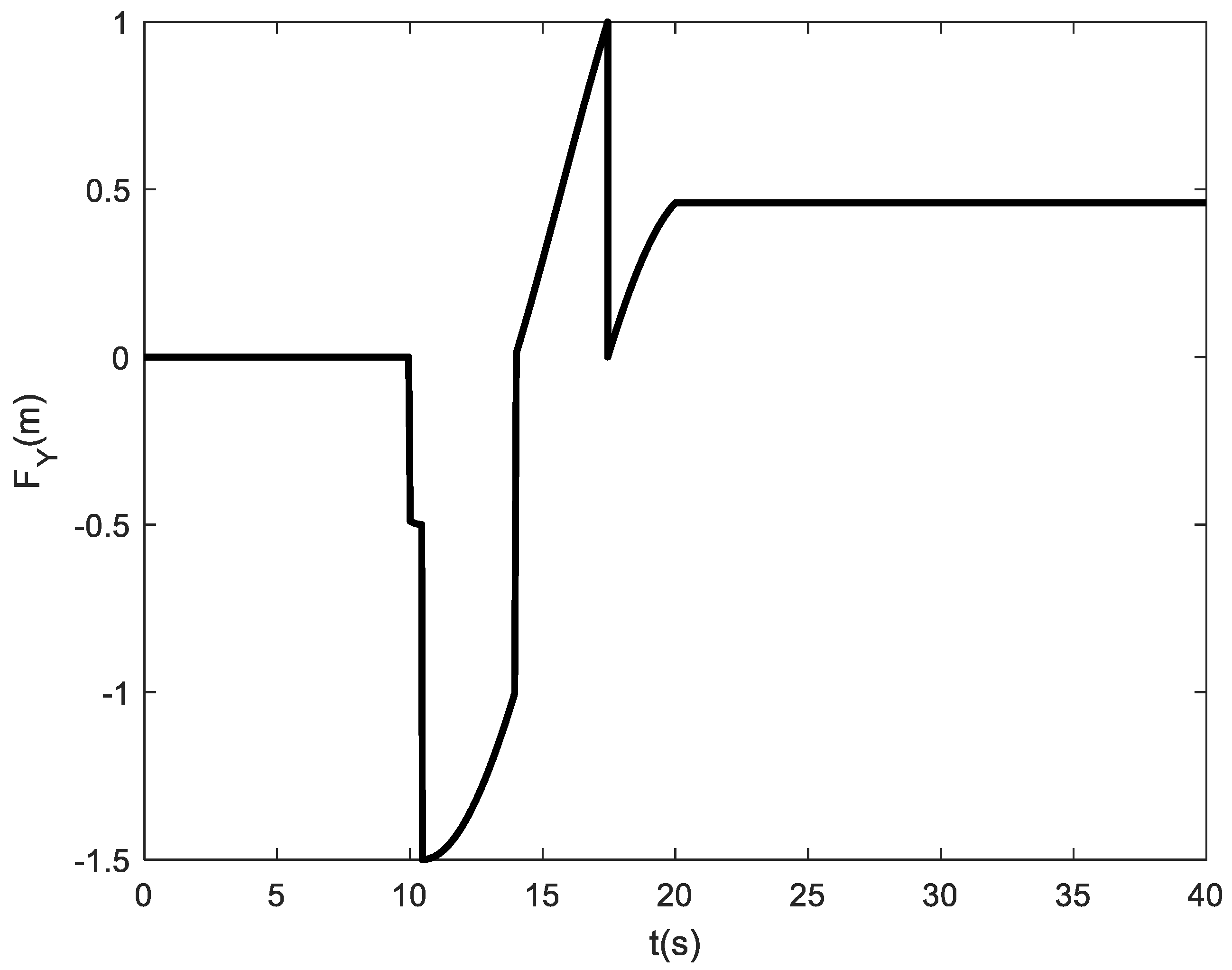
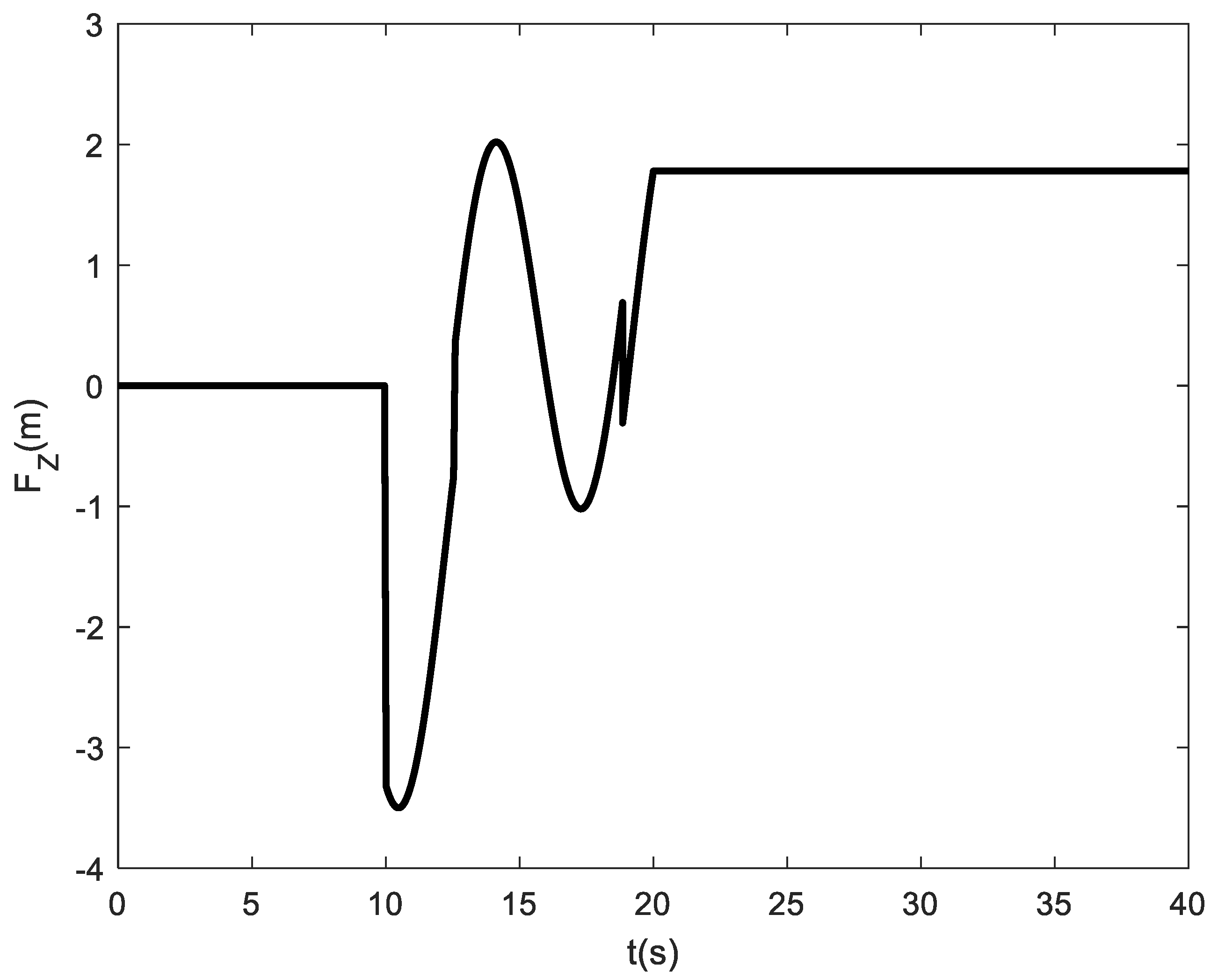
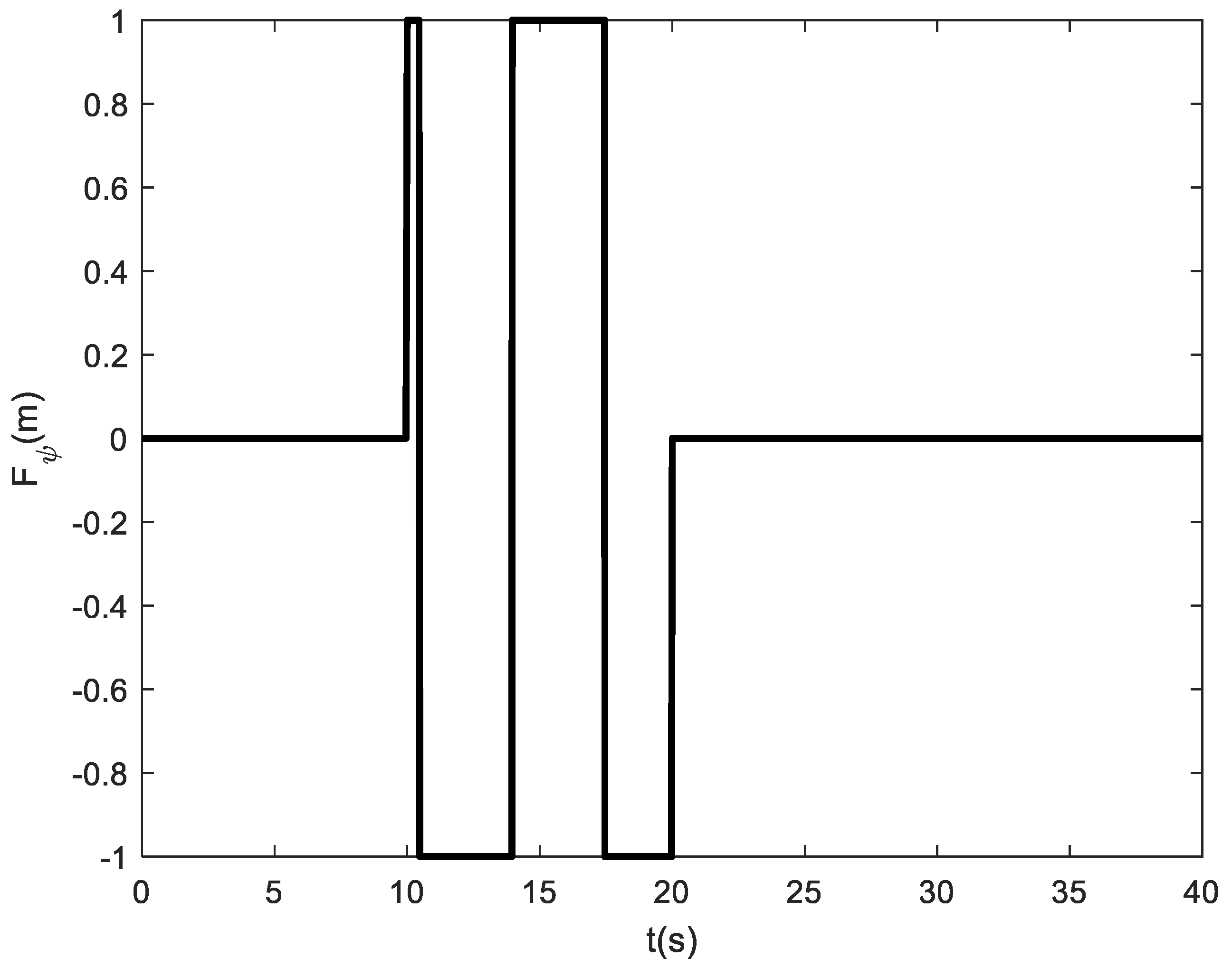
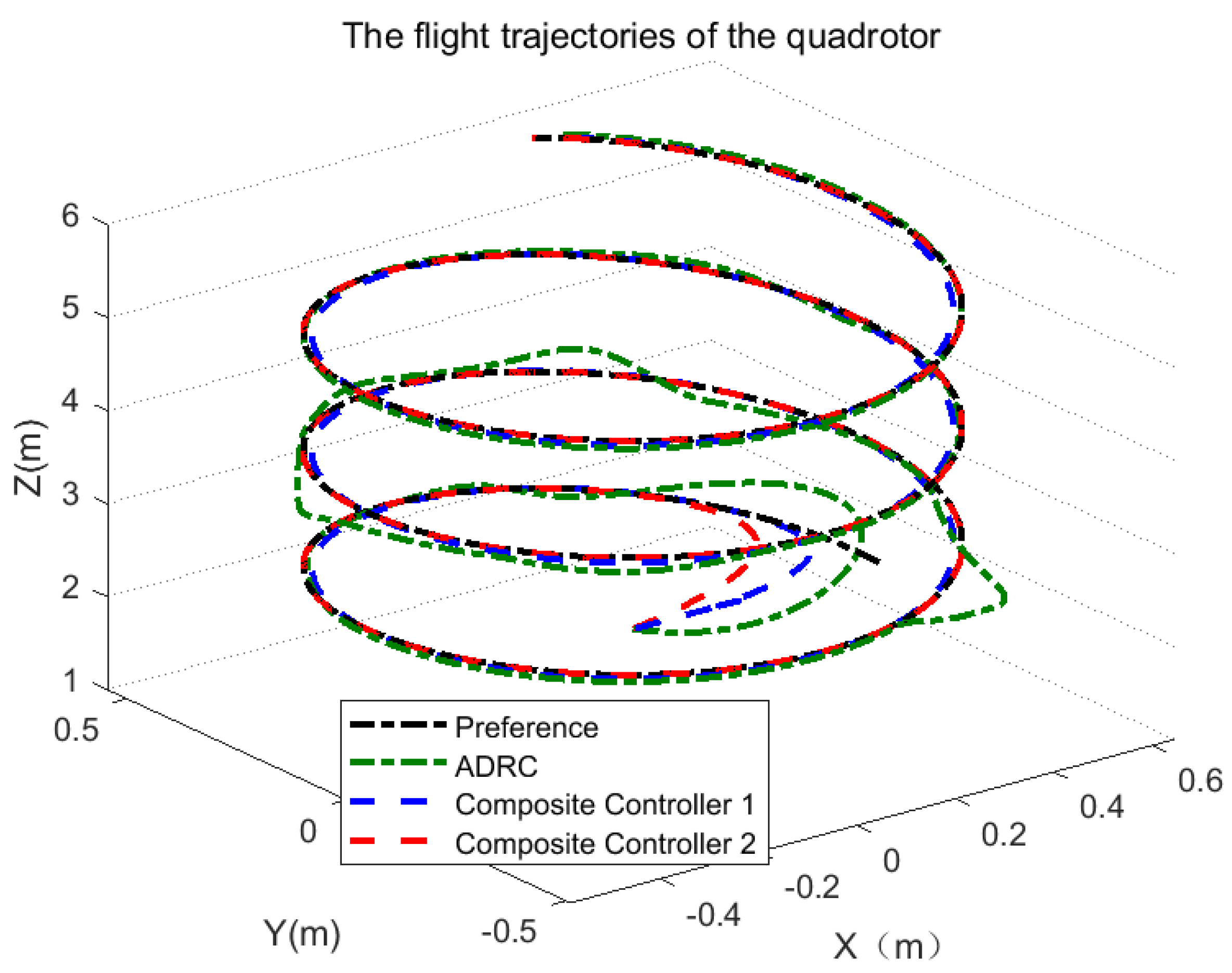
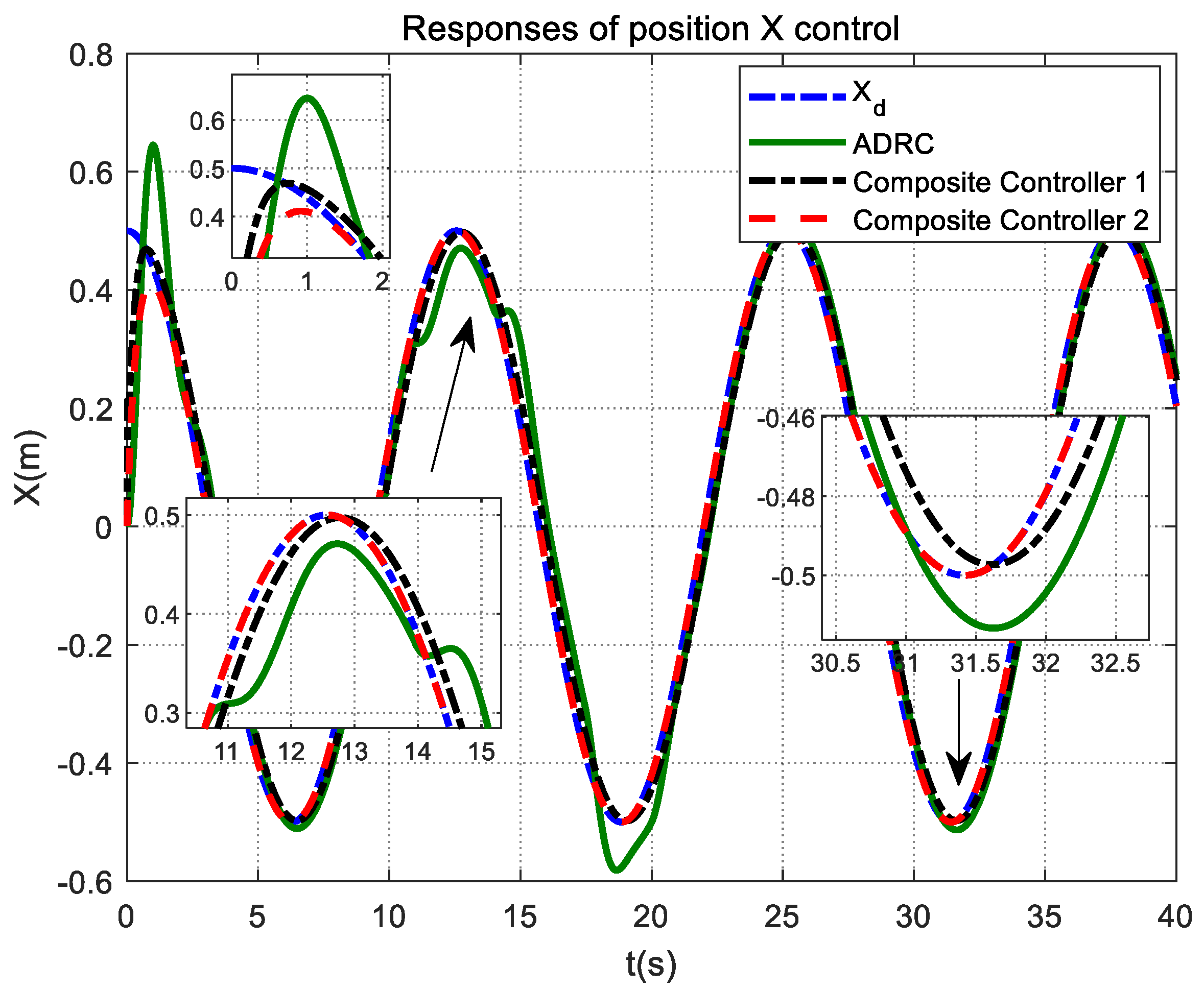


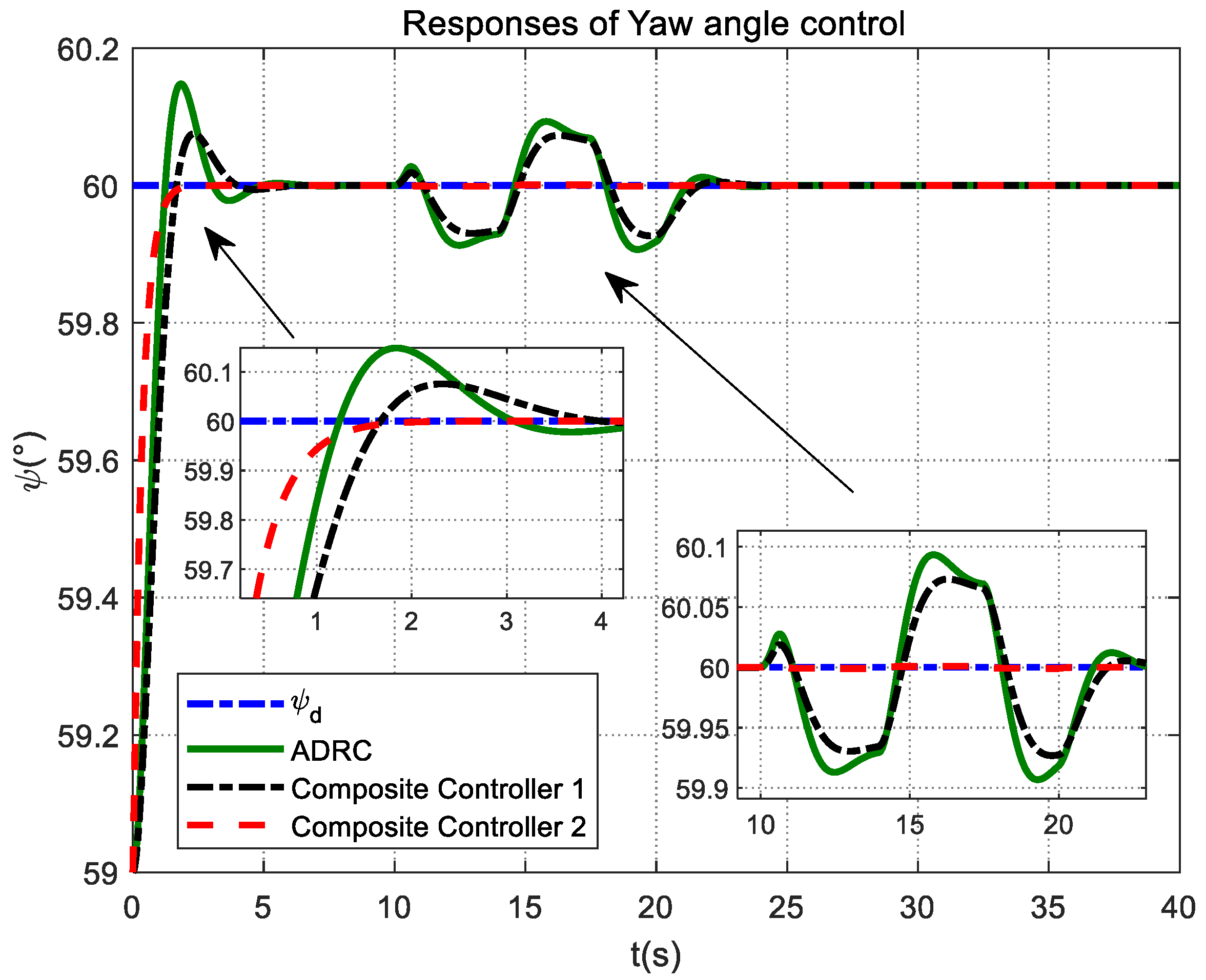
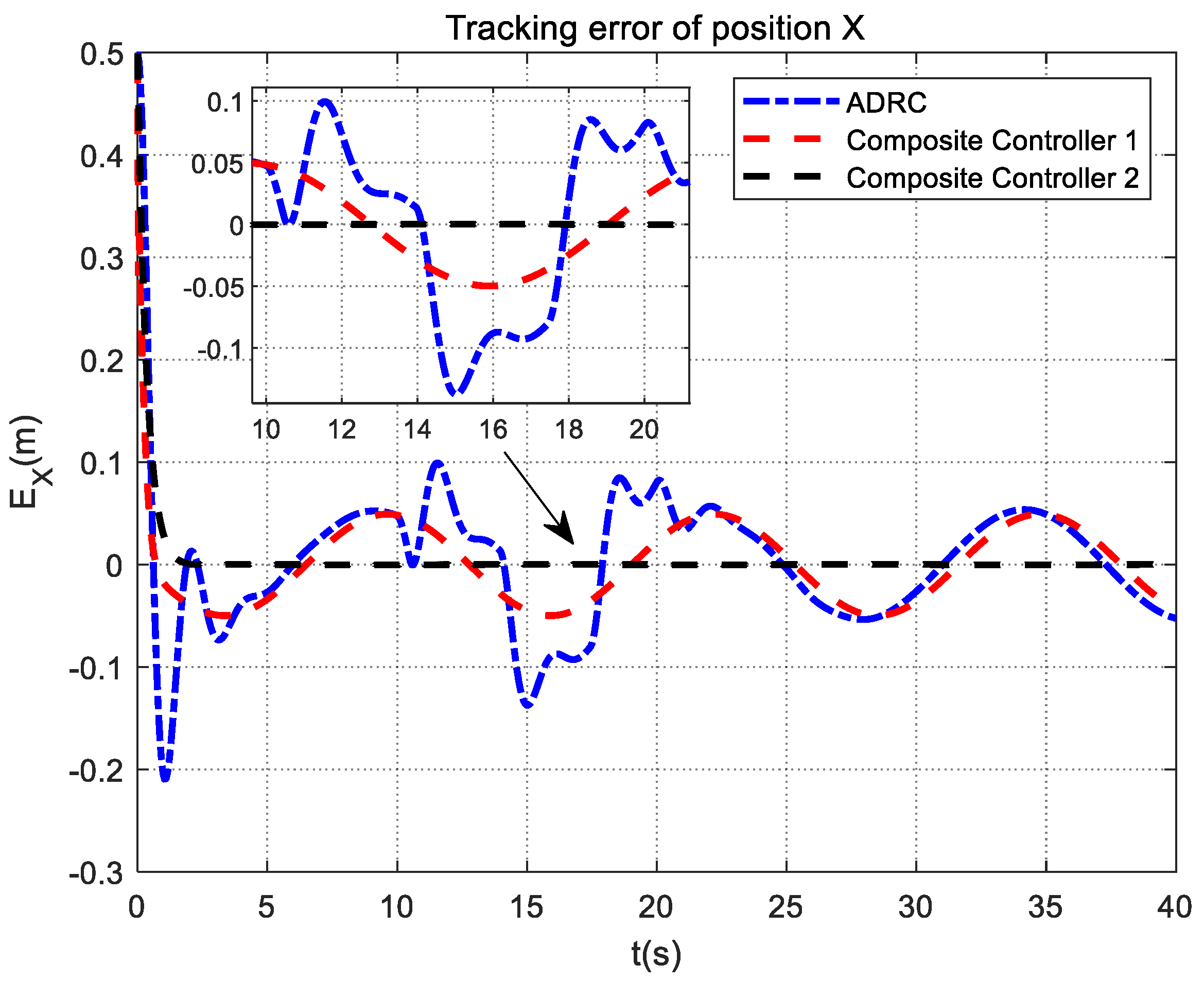

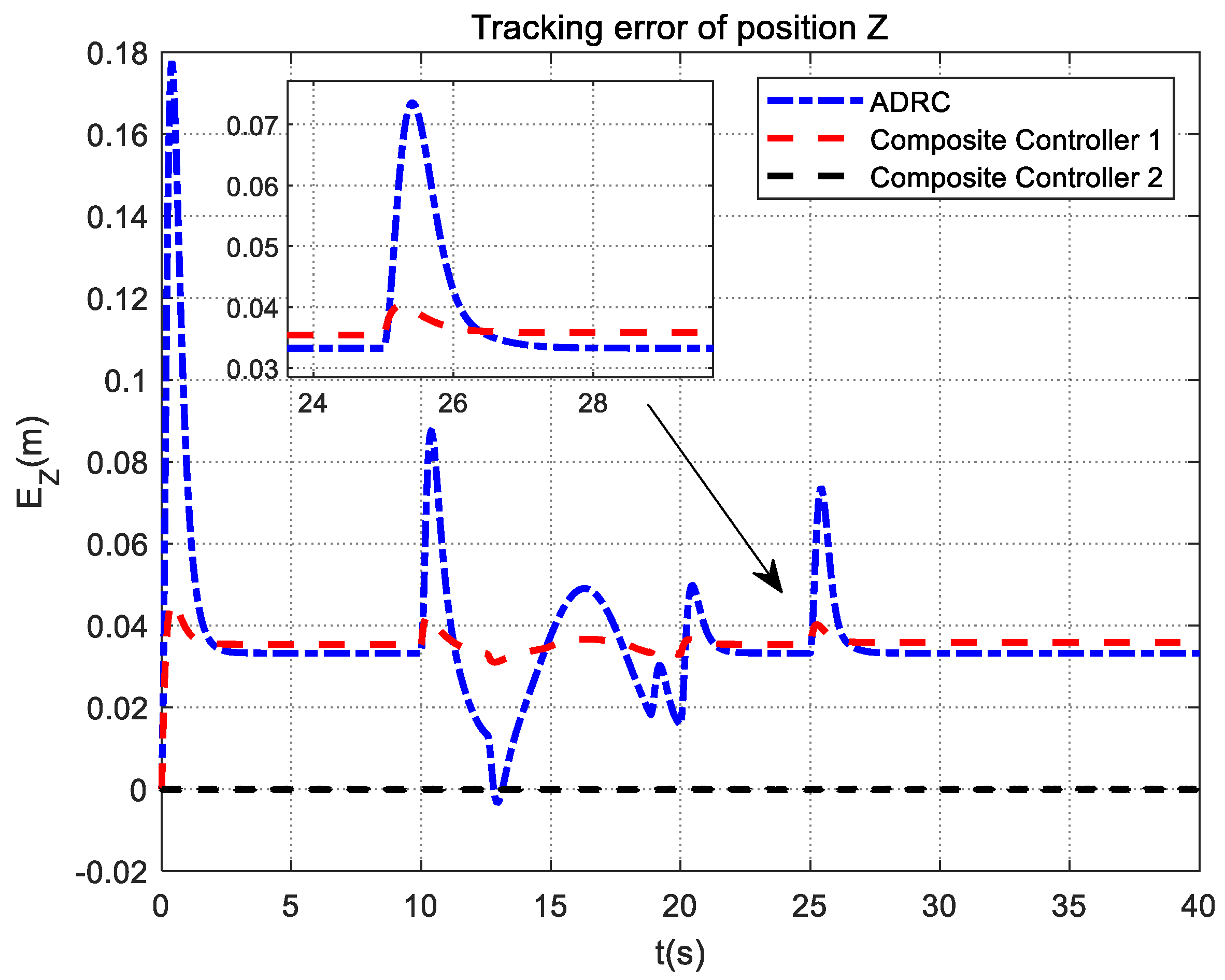

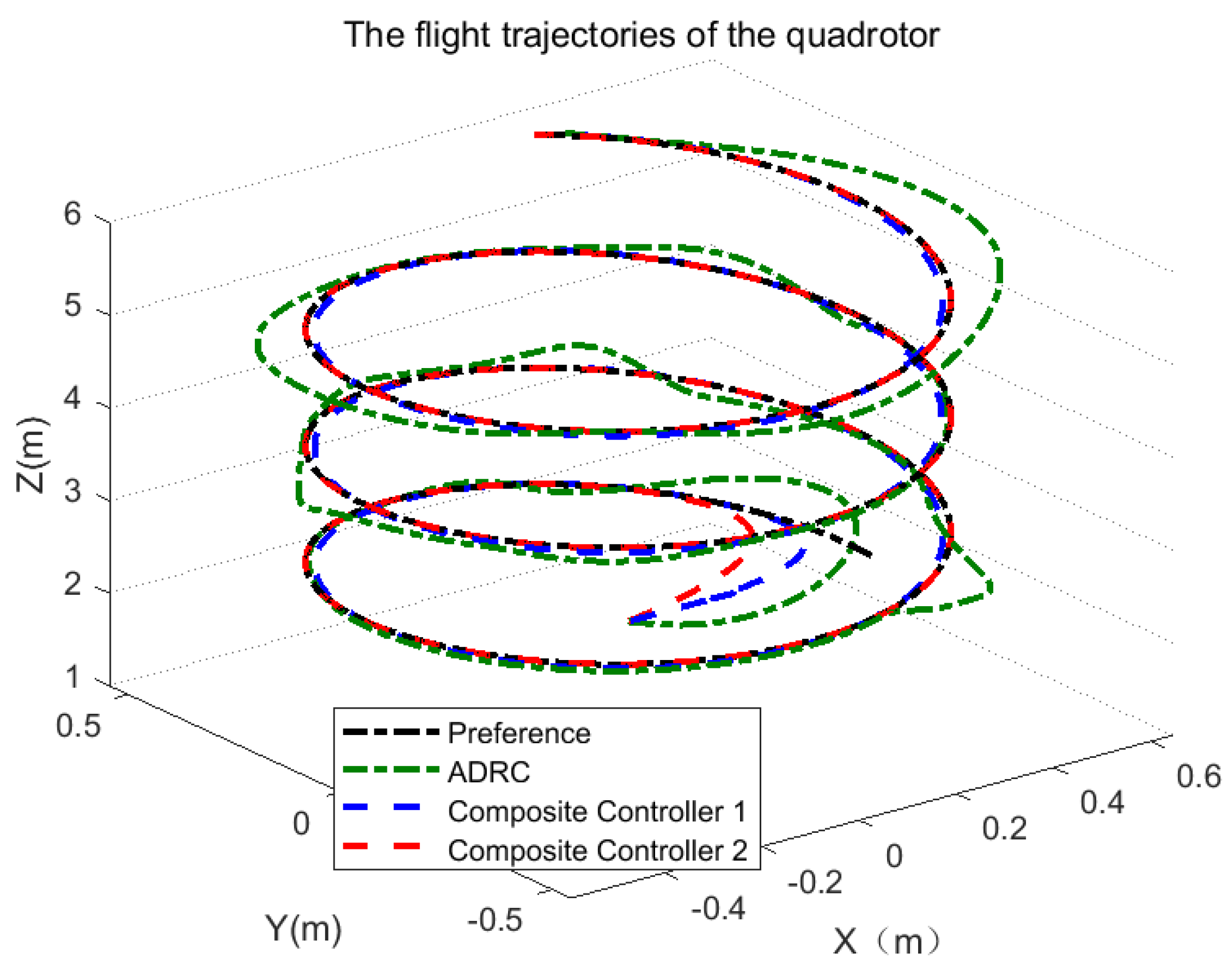
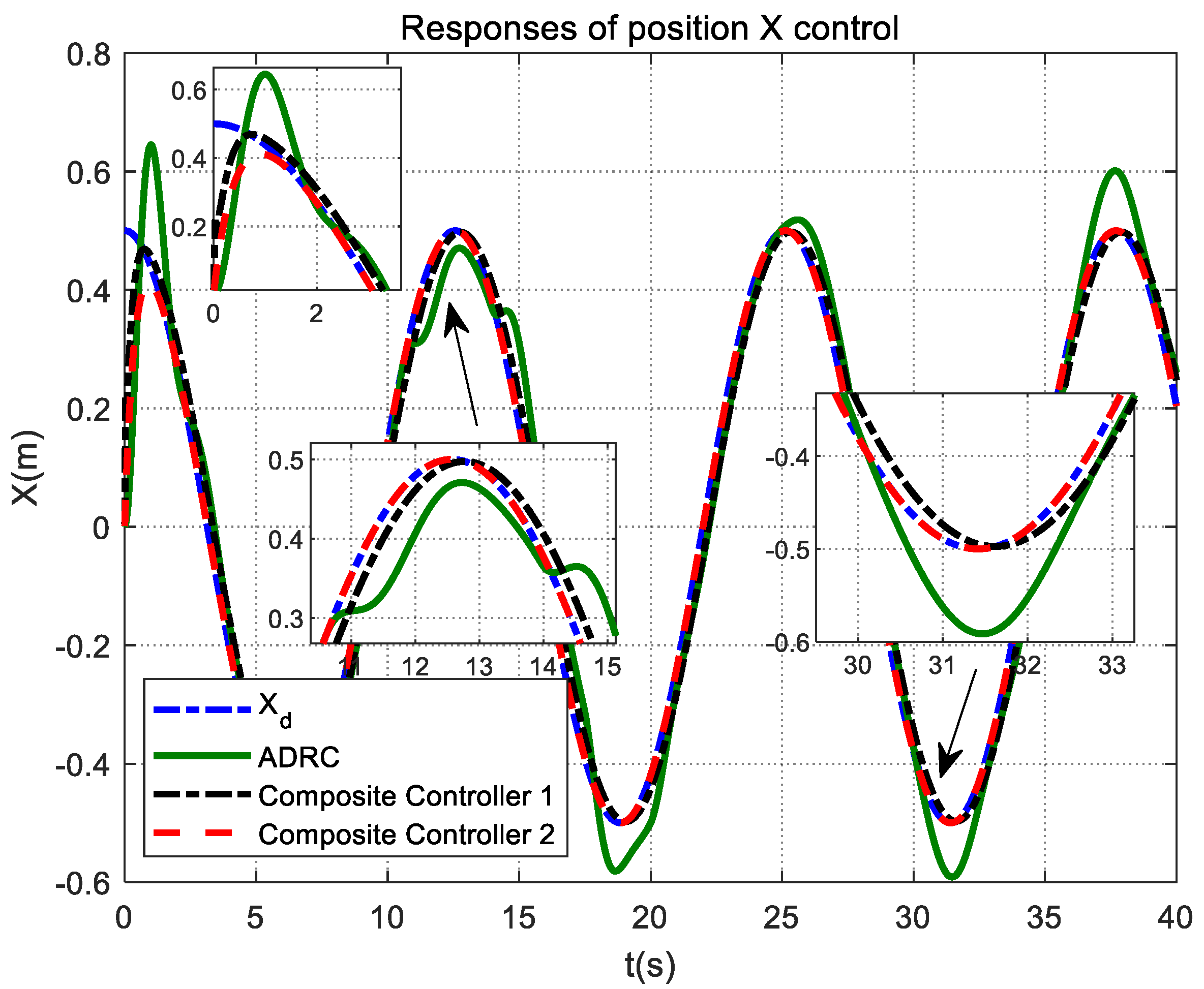

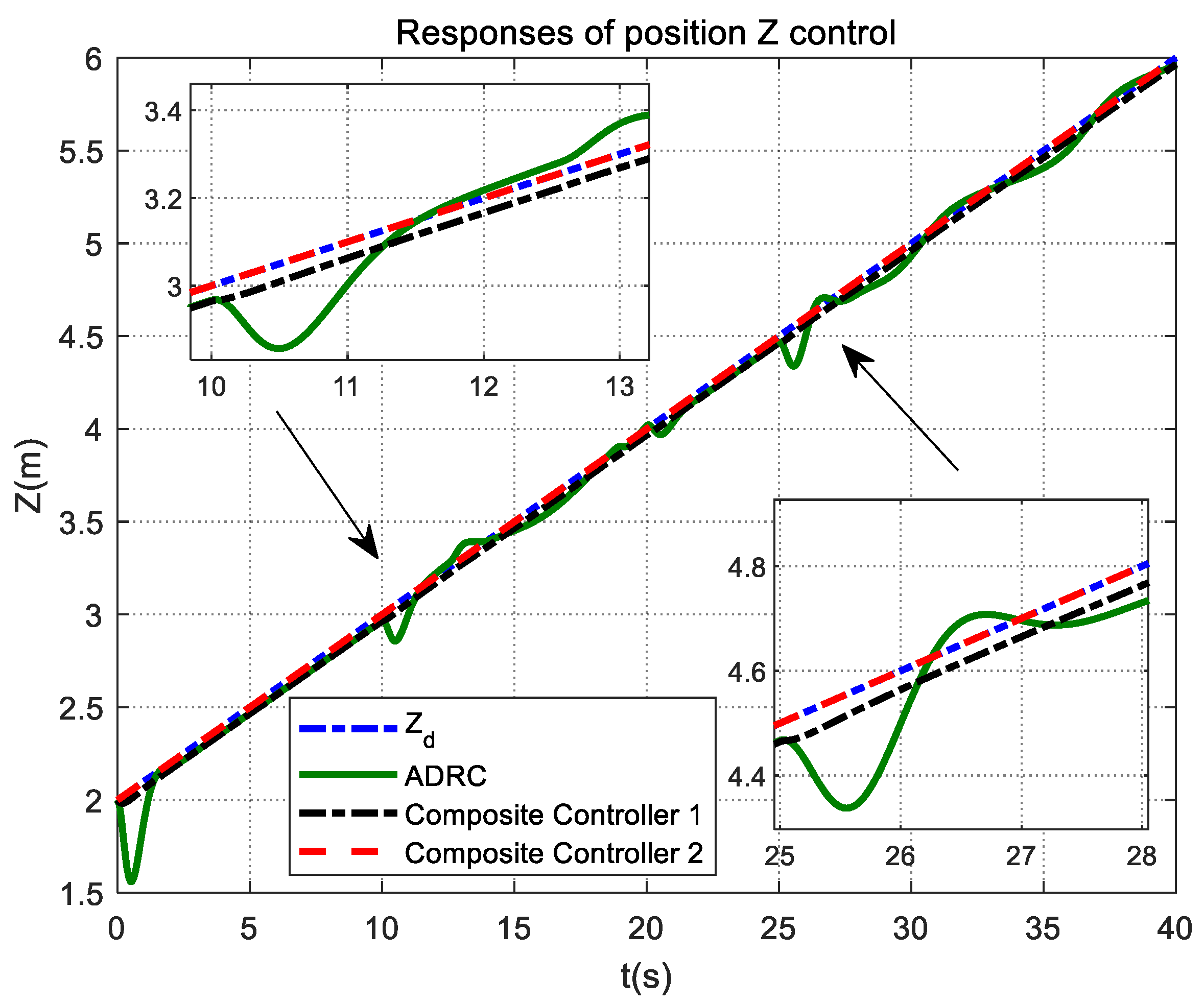
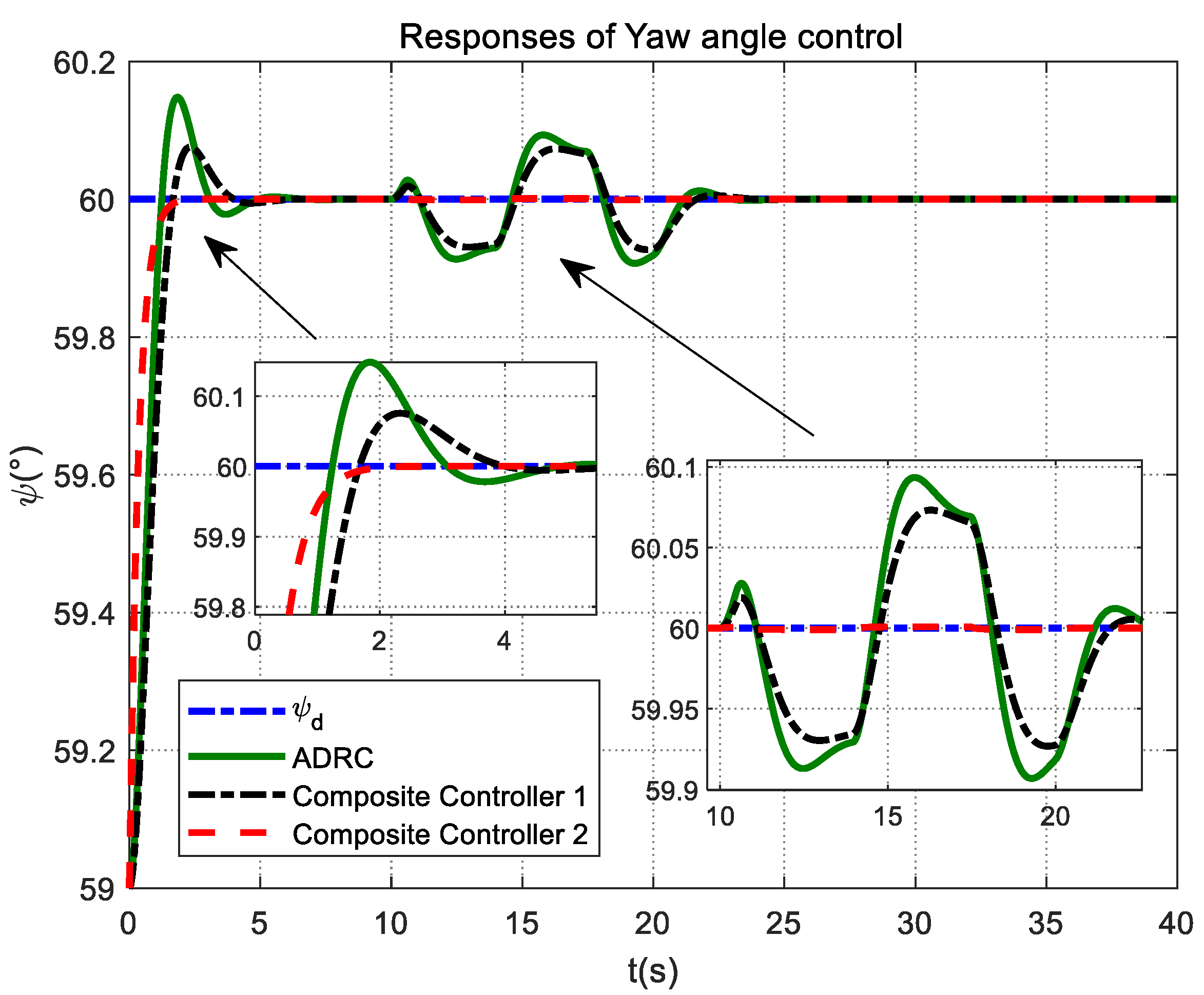

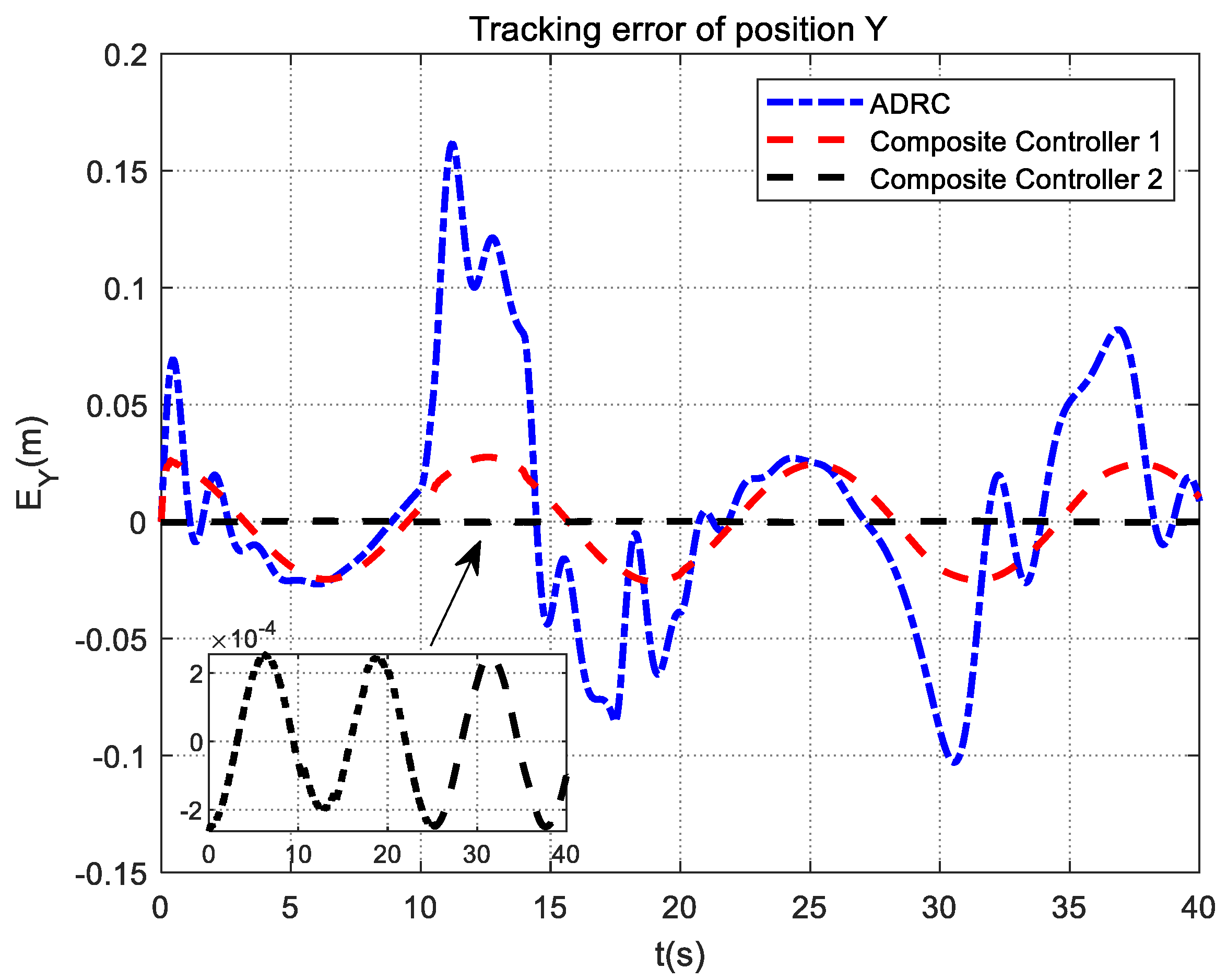
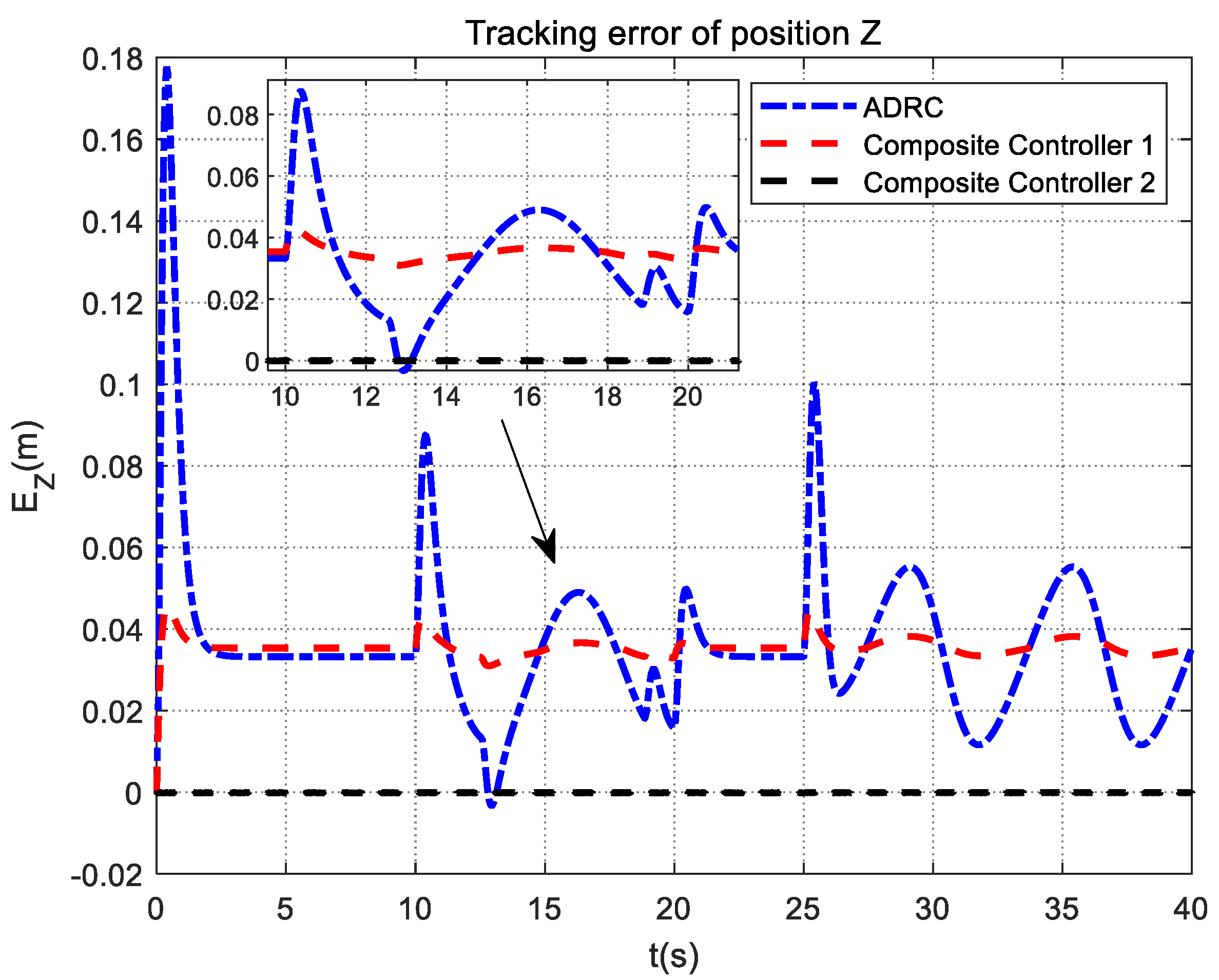

| Symbol | Value | Symbol | Value | Symbol | Value | Symbol | Value | Symbol | Value |
|---|---|---|---|---|---|---|---|---|---|
| 0.0552 | 0.0552 | 0.11 | 0.012 | M | 2 | ||||
| G | 9.8 | 0.8 | 3000 | 3000 | 500 | ||||
| 2500 | 125 | 100 | 0.9 | 1.2 | |||||
| 36 | 432 | 1728 | 36 | 432 | |||||
| 1728 | 0.5 | 0.09 | 0.8 | 3000 | |||||
| 3000 | 500 | 2500 | 125 | 100 | |||||
| 0.8 | 3000 | 3000 | 500 | 2500 | |||||
| 125 | 100 | 0.9 | 1.2 | 36 | |||||
| 432 | 1728 | 36 | 432 | 1728 | |||||
| 0.5 | 0.09 | 0.8 | 3000 | 3000 | |||||
| 500 | 2500 | 125 | 100 | 0.9 | |||||
| 1.2 | 36 | 432 | 1728 | 36 | |||||
| 432 | 1728 | 0.5 | 0.09 | 0.9 | |||||
| 1.2 | 36 | 432 | 1728 | 36 | |||||
| 432 | 1728 | 0.5 | 0.09 | 0.8 | |||||
| 3000 | 3000 | 500 | 2500 | 125 | |||||
| 100 | 0.9 | 1.2 | 36 | 432 | |||||
| 1728 | 36 | 432 | 1728 | 0.5 | |||||
| 0.09 | 0.8 | 3000 | 3000 | 500 | |||||
| 2500 | 125 | 100 | 0.9 | 1.2 | |||||
| 36 | 432 | 1728 | 36 | 432 | |||||
| 1728 | 0.5 | 0.09 |
Publisher’s Note: MDPI stays neutral with regard to jurisdictional claims in published maps and institutional affiliations. |
© 2022 by the authors. Licensee MDPI, Basel, Switzerland. This article is an open access article distributed under the terms and conditions of the Creative Commons Attribution (CC BY) license (https://creativecommons.org/licenses/by/4.0/).
Share and Cite
Liu, L.; Liu, J.; Li, J.; Ji, Y.; Song, Y.; Xu, L.; Niu, W. Fault-Tolerant Control for Quadrotor Based on Fixed-Time ESO. Mathematics 2022, 10, 4386. https://doi.org/10.3390/math10224386
Liu L, Liu J, Li J, Ji Y, Song Y, Xu L, Niu W. Fault-Tolerant Control for Quadrotor Based on Fixed-Time ESO. Mathematics. 2022; 10(22):4386. https://doi.org/10.3390/math10224386
Chicago/Turabian StyleLiu, Lei, Junjie Liu, Junfang Li, Yuehui Ji, Yu Song, Liang Xu, and Wenxing Niu. 2022. "Fault-Tolerant Control for Quadrotor Based on Fixed-Time ESO" Mathematics 10, no. 22: 4386. https://doi.org/10.3390/math10224386





